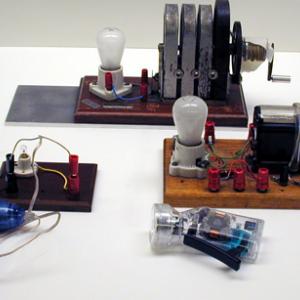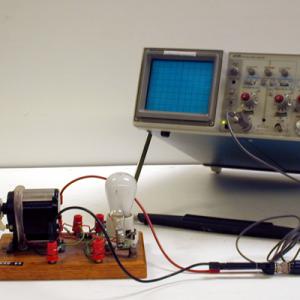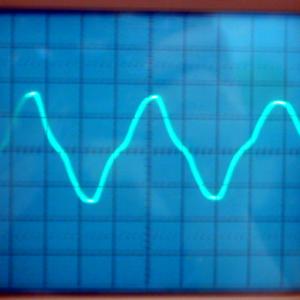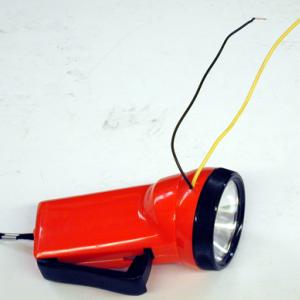College of Liberal Arts & Sciences
5K40.80 - Hand Crank Generators - Genecon
Video Credit: Jonathan M. Sullivan-Wood.
These should be ready to go once you set them out on the table. The larger generators you may want to clamp down if you are trying to crank them very fast.
CAUTION: The two large generators put out up to 120 VAC so you need to be careful where you put your hands when cranking the generator so that you do not become the light bulb.
Bipolar LED's may be used to show polarity reversal. The generators will have to be cranked very slowly to see this effect. Faster cranking of the AC generator will produce yellow (red+green=yellow).
The generator flashlight with the external wires will produce a very nice sine wave when connected to the oscilloscope. The small crank generator also produces fair sine waves when viewed on the oscilloscope. The large crank generator produces waves with spikes when viewed on the oscilloscope and is not the preferred one to use.
Using the Genecon generators: A subtle comparison can be made between an inductor and a capacitor using a hand crank DC generator. When connected to the capacitor, the generator is hard to crank at first and gets easier to crank as you continue. When you quit cranking the generator will keep going on its own in the same direction as you cranked it. Do the same with an inductor and it gets harder to crank as you continue and when you let go, it stops and turns in the opposite direction you originally cranked it.
- Ole Anton Haugland, "A Well-Known But Still Surprising Generator", TPT, Vol. 52, #9, Dec. 2014, p. 532.
- John E. Carlson, "Faraday's Law and the Constant Velocity Car", TPT, Vol. 43, #9, Dec. 2005, p. 618.
- Wojciech Dindorf, "Unconventional Dynamo", TPT, Vol. 40, #4, Apr. 2002, p. 220.
- David T. Kagan and Robert Keith, "Building a Cheap Simple Generator", TPT, Vol. 37, #4, Apr. 1999, p. 248.
- Robert F. Neff, "Genecon Visualized", TPT, Vol. 33, #5, May 1995, p. 320.
- Mario Iona, "Generator Efficiency", TPT, Vol. 26, #9, Dec. 1988, p. 555.
- Chris Chiaverina, "The Genecon Hand-Operated Generator", TPT, Vol. 26, #1, Jan 1988, p. 41.
- Tom Kobilarcik, Ed McNeil, Chris Chiaverina, and Earl Zwicker, "Doing Physics", TPT, Vol. 25, #4, Apr. 1987, p. 248.
- L. V. Hmurcik and J. P. Micinilio, "Contrasts Between Maximum Power Transfer and Maximum Efficiency", TPT, Vol. 24, #8, Nov. 1986, p. 492.
- D. Rae Carpenter Jr. and Richard B. Minnix, "B-250. Genecon", DICK and RAE Physics Demo Notebook, 1993.
- G. D. Freier and F. J. Anderson, "Mv-4", A Demonstration Handbook for Physics.
- G. D. Freier and F. J. Anderson, "Eq-7", A Demonstration Handbook for Physics.
- George M. Hopkins, "Hard Power Dynamo", Experimental Science, p. 487.
- Jodi and Roy McCullough, "Electromagnetism with a Toy Sweeper", The Role of Toys in Teaching Physics, p. 4.202.
- Robert Ehrlich, "N.7. Hand-Powered Generator", Turning the World Inside Out and 174 Other Simple Physics Demonstrations, p. 170.
- W. Bolton, "28 Generation of Alternating Current", Book 4 - Electricity, Physics Experiments and Projects, 1968, p. 54.
Disclaimer: These demonstrations are provided only for illustrative use by persons affiliated with The University of Iowa and only under the direction of a trained instructor or physicist. The University of Iowa is not responsible for demonstrations performed by those using their own equipment or who choose to use this reference material for their own purpose. The demonstrations included here are within the public domain and can be found in materials contained in libraries, bookstores, and through electronic sources. Performing all or any portion of any of these demonstrations, with or without revisions not depicted here entails inherent risks. These risks include, without limitation, bodily injury (and possibly death), including risks to health that may be temporary or permanent and that may exacerbate a pre-existing medical condition; and property loss or damage. Anyone performing any part of these demonstrations, even with revisions, knowingly and voluntarily assumes all risks associated with them.



